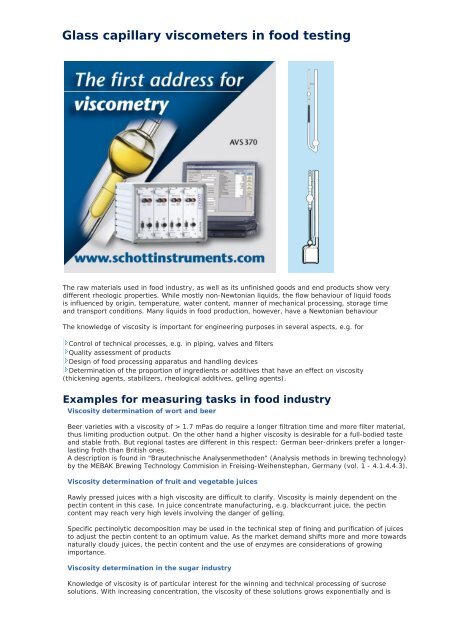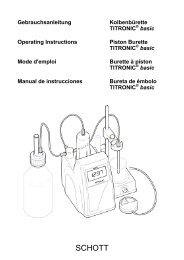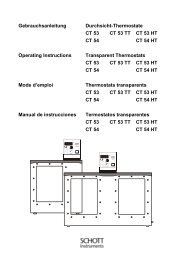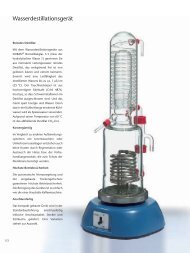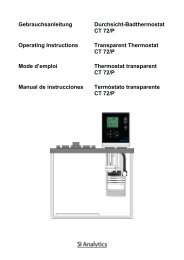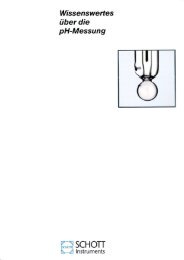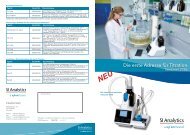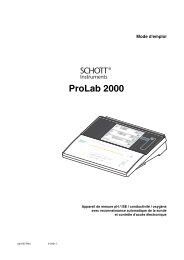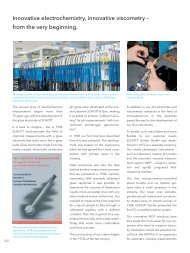Glass capillary viscometers in food testing - SI Analytics
Glass capillary viscometers in food testing - SI Analytics
Glass capillary viscometers in food testing - SI Analytics
Create successful ePaper yourself
Turn your PDF publications into a flip-book with our unique Google optimized e-Paper software.
<strong>Glass</strong> <strong>capillary</strong> <strong>viscometers</strong> <strong>in</strong> <strong>food</strong> test<strong>in</strong>g<br />
The raw materials used <strong>in</strong> <strong>food</strong> <strong>in</strong>dustry, as well as its unf<strong>in</strong>ished goods and end products show very<br />
different rheologic properties. While mostly non-Newtonian liquids, the flow behaviour of liquid <strong>food</strong>s<br />
is <strong>in</strong>fluenced by orig<strong>in</strong>, temperature, water content, manner of mechanical process<strong>in</strong>g, storage time<br />
and transport conditions. Many liquids <strong>in</strong> <strong>food</strong> production, however, have a Newtonian behaviour<br />
The knowledge of viscosity is important for eng<strong>in</strong>eer<strong>in</strong>g purposes <strong>in</strong> several aspects, e.g. for<br />
Control of technical processes, e.g. <strong>in</strong> pip<strong>in</strong>g, valves and filters<br />
Quality assessment of products<br />
Design of <strong>food</strong> process<strong>in</strong>g apparatus and handl<strong>in</strong>g devices<br />
Determ<strong>in</strong>ation of the proportion of <strong>in</strong>gredients or additives that have an effect on viscosity<br />
(thicken<strong>in</strong>g agents, stabilizers, rheological additives, gell<strong>in</strong>g agents).<br />
Examples for measur<strong>in</strong>g tasks <strong>in</strong> <strong>food</strong> <strong>in</strong>dustry<br />
Viscosity determ<strong>in</strong>ation of wort and beer<br />
Beer varieties with a viscosity of > 1.7 mPas do require a longer filtration time and more filter material,<br />
thus limit<strong>in</strong>g production output. On the other hand a higher viscosity is desirable for a full-bodied taste<br />
and stable froth. But regional tastes are different <strong>in</strong> this respect: German beer-dr<strong>in</strong>kers prefer a longerlast<strong>in</strong>g<br />
froth than British ones.<br />
A description is found <strong>in</strong> "Brautechnische Analysenmethoden" (Analysis methods <strong>in</strong> brew<strong>in</strong>g technology)<br />
by the MEBAK Brew<strong>in</strong>g Technology Commision <strong>in</strong> Freis<strong>in</strong>g-Weihenstephan, Germany (vol. 1 - 4.1.4.4.3).<br />
Viscosity determ<strong>in</strong>ation of fruit and vegetable juices<br />
Rawly pressed juices with a high viscosity are difficult to clarify. Viscosity is ma<strong>in</strong>ly dependent on the<br />
pect<strong>in</strong> content <strong>in</strong> this case. In juice concentrate manufactur<strong>in</strong>g, e.g. blackcurrant juice, the pect<strong>in</strong><br />
content may reach very high levels <strong>in</strong>volv<strong>in</strong>g the danger of gell<strong>in</strong>g.<br />
Specific pect<strong>in</strong>olytic decomposition may be used <strong>in</strong> the technical step of f<strong>in</strong><strong>in</strong>g and purification of juices<br />
to adjust the pect<strong>in</strong> content to an optimum value. As the market demand shifts more and more towards<br />
naturally cloudy juices, the pect<strong>in</strong> content and the use of enzymes are considerations of grow<strong>in</strong>g<br />
importance.<br />
Viscosity determ<strong>in</strong>ation <strong>in</strong> the sugar <strong>in</strong>dustry<br />
Knowledge of viscosity is of particular <strong>in</strong>terest for the w<strong>in</strong>n<strong>in</strong>g and technical process<strong>in</strong>g of sucrose<br />
solutions. With <strong>in</strong>creas<strong>in</strong>g concentration, the viscosity of these solutions grows exponentially and is
thereby of decisive importance for the crystallisation disposition of treacle.<br />
While the crystallisation disposition of a sucrose solution is favoured by <strong>in</strong>creas<strong>in</strong>g concentration<br />
(supersaturation), it is disfavoured by an <strong>in</strong>creas<strong>in</strong>g proportion of multiple saccharides. The viscosity<br />
grows with grow<strong>in</strong>g molecular mass of the solution components.<br />
Glucose syrups of equal saccharification grade have different saccharide fractions and thus different<br />
viscose behaviour. As they are used as cristallisation <strong>in</strong>hibitors <strong>in</strong> the manufactur<strong>in</strong>g of sweets, the<br />
viscosity is an important technological parameter here. After all, who wants his chew<strong>in</strong>g candy to turn<br />
<strong>in</strong>to a tooth-breaker with<strong>in</strong> such a short time?<br />
Viscosity determ<strong>in</strong>ation <strong>in</strong> the dairy <strong>in</strong>dustry<br />
The vary<strong>in</strong>g orig<strong>in</strong> and composition of milk results <strong>in</strong> a very different rheological behaviour of milk and<br />
dairy products. The viscosity of milk, cream, condensed milk etc. is <strong>in</strong>fluenced by fat content, dry matter<br />
concentration and largely by the process<strong>in</strong>g conditions.<br />
The addition of hydrocolloids (thicken<strong>in</strong>g agents, rheological additives, gell<strong>in</strong>g agents) and of stabilizers<br />
strongly <strong>in</strong>creases viscosity. The viscosity measurement provides valuable <strong>in</strong>formation about their<br />
chemical structure and their <strong>in</strong>teraction with the milk components. Or would you like your dr<strong>in</strong>k<strong>in</strong>g<br />
yoghurt to end up sliceable with<strong>in</strong> the bottle after just two days <strong>in</strong> the refrigerator?<br />
The aims of viscosity measurement can be summarized as<br />
follows:<br />
Optimiz<strong>in</strong>g the mashability of beer<br />
Select<strong>in</strong>g filtration strategies and times<br />
Assess<strong>in</strong>g the quality of malt and wort <strong>in</strong> beer<br />
Provid<strong>in</strong>g <strong>in</strong>formation for the design of <strong>in</strong>dustrial apparatus and equipment<br />
Characteris<strong>in</strong>g the gell<strong>in</strong>g capacity of pect<strong>in</strong> by determ<strong>in</strong>ation of the limit<strong>in</strong>g viscosity number<br />
Acquisition of parameters for the conduction of the pect<strong>in</strong>olytic process for the optimisation of f<strong>in</strong><strong>in</strong>g<br />
and purification of fruit and vegetable juices<br />
Supervis<strong>in</strong>g e.g. automatic dos<strong>in</strong>g and bottl<strong>in</strong>g plants<br />
Supervis<strong>in</strong>g e.g. automatic dos<strong>in</strong>g and bottl<strong>in</strong>g plants<br />
Quality evaluation (taste, color stability, life)<br />
Develop<strong>in</strong>g formulations<br />
Solution<br />
After verify<strong>in</strong>g whether the <strong>food</strong> liquid to be analyzed may sufficiently be regarded as a Newtonian fluid,<br />
all types of <strong>capillary</strong> <strong>viscometers</strong> can be employed. Difficulties may show up <strong>in</strong> the registration of the<br />
liquid meniscus. Dairy products for <strong>in</strong>stance are hard to detect optoelectronically (via light barrier) <strong>in</strong> the<br />
viscometer because of their low transparence and their dripp<strong>in</strong>g effects.<br />
Employ<strong>in</strong>g TC <strong>viscometers</strong> <strong>in</strong>volves frequent thorough clean<strong>in</strong>g, as the thermistors tend to <strong>in</strong>crustations<br />
and foul<strong>in</strong>g. Measur<strong>in</strong>g the viscosity of beer, fruit juices etc., is an easier task. As these liquids tend to<br />
froth, Ostwald or micro Ostwald <strong>viscometers</strong> are recommended for automatic measurements. The<br />
standard deviation for viscosity measurements of beer wort with Ostwald/micro Ostwald <strong>viscometers</strong><br />
was 0,004 mPas, compared to 0,02 mPas for measurements with the Höppler viscometer. Viscosity<br />
measurements of fruit juices have likewise produced good results.<br />
Further Read<strong>in</strong>g<br />
Users manuals for glass <strong>capillary</strong> <strong>viscometers</strong>, by SCHOTT Instruments GmbH<br />
Theory and Practice of Capillary Viscometry, by SCHOTT Instruments GmbH<br />
DIN 1342 (2) Newtonian liquids<br />
DIN 51 550 Viscosity determ<strong>in</strong>ation basics<br />
DIN 51 562 Measur<strong>in</strong>g of c<strong>in</strong>ematic viscosity with Ubbelohde <strong>viscometers</strong><br />
DIN 53 012 Capillary viscometry of newtonian liquids, error sources and corrections


